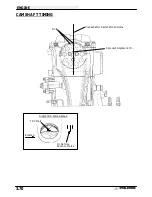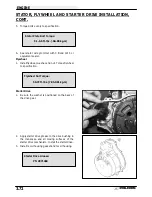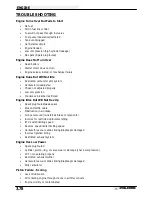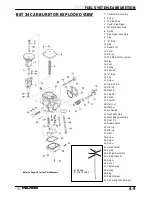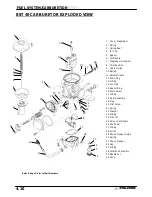
FUEL SYSTEM/CARBURETION
4.1
JETTING GUIDELINES
Changes in altitude and temperature affect air density, which is essentially the amount of oxygen available for
combustion. In low elevations and cold temperatures, the air has more oxygen. In higher elevations and higher
temperatures, the air is less dense.
Carburetors are calibrated for an altitude of 0-3000 ft. (0-900 meters) and ambient temperatures b40
and +80
°
F (+5
°
to +26
°
C). Carburetors must be re-calibrated if operated outside the production temperature
and/or altitude range. The main jet installed in production is not correct for all altitudes and/or temperatures. In
addition, air screw / pilot screw adjustments may be required to suit operating conditions.
CAUTION:
A main jet that is too small will cause a lean operating condition and may cause serious engine damage.
Select the correct main jet carefully for elevation and temperature according to the charts in the General/
Specifications Chapter, or in the Owner’s Safety and Maintenance Manual for each particular model.
MAIN JET SELECTION
IMPORTANT: The following guidelines must be followed when establishing a main jet setting:
1.
Select the lowest anticipated temperature at which the machine will be operated.
2.
Determine the lowest approximate altitude at which the machine will be operated.
3.
Select the correct main jet from the chart.
4.
Clutching changes may also be required for changes in elevation. Refer to clutching charts in General /
Specifications Chapter 1 for recommendations.
WARNING
Gasoline is extremely flammable and explosive under certain conditions.
Always stop the engine and refuel outdoors or in a well ventilated area.
Do not overfill the tank. Do not fill the tank neck.
Never start the engine or let it run in an enclosed area. Gasoline powered engine exhaust fumes are poison-
ous and can cause loss of consciousness and death in a short time.
Never drain the float bowl when the engine is hot. Severe burns may result.
Do not smoke or allow open flames or sparks in or near the area where refueling is performed or where
gasoline is stored.
If you get gasoline in your eyes or if you should swallow gasoline, see your doctor immediately.
If you spill gasoline on your skin or clothing, immediately wash it off with soap and water and change clothing.
Summary of Contents for Sportsman 400
Page 6: ...SPORTSMAN 400 A01CH42AC GENERAL INFORMATION 1 4 MODEL COLOR IDENTIFICATION ...
Page 21: ...Newton Meter to Pound Foot and Pound Inch GENERAL INFORMATION 1 19 TORQUE CONVERSIONS ...
Page 22: ...Newton Meter to Pound Foot and Pound Inch GENERAL INFORMATION 1 20 TORQUE CONVERSIONS ...
Page 152: ...Forward FUEL SYSTEM CARBURETION 4 2 FUEL TANK ASSEMBLY ...
Page 366: ...ELECTRONIC SPEEDOMETER WIRING DIAGRAM ELECTRICAL 10 32 ...
Page 372: ...ELECTRICAL 10 38 NOTES ...
Page 379: ...ELECTRICAL 10 39 WIRING DIAGRAM 2001 SPORTSMAN 400 ...
Page 380: ...ELECTRICAL 10 40 WIRING DIAGRAM 2001 SPORTSMAN 500 EARLY ...
Page 381: ...ELECTRICAL 10 41 WIRING DIAGRAM 2001 SPORTSMAN 500 LATE ...



